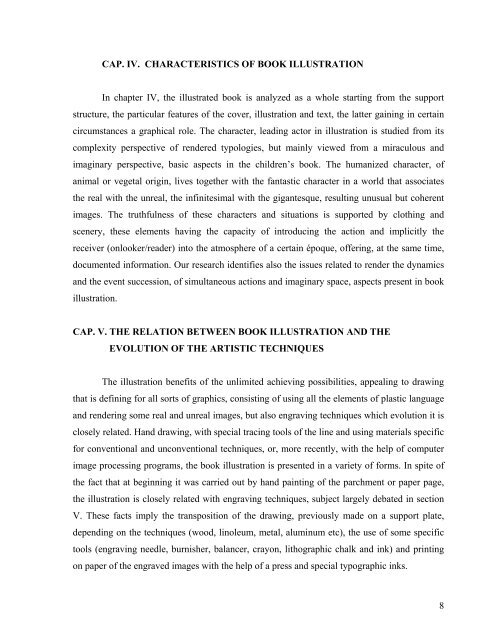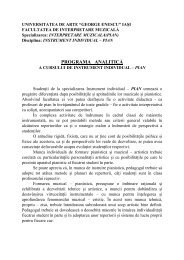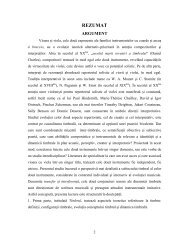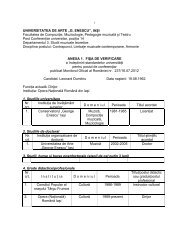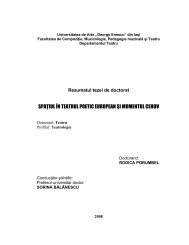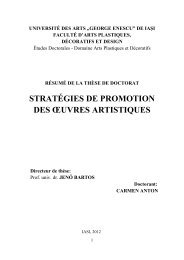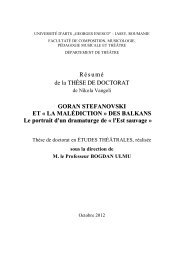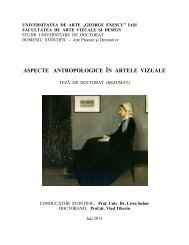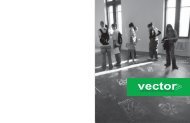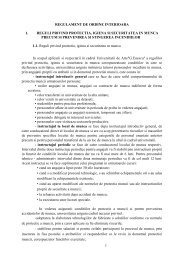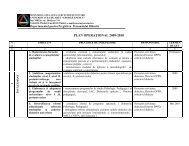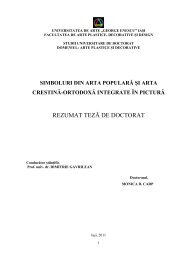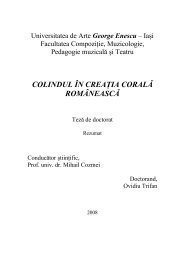Caloian Cezarina - Universitatea de Arte "George Enescu"
Caloian Cezarina - Universitatea de Arte "George Enescu"
Caloian Cezarina - Universitatea de Arte "George Enescu"
Create successful ePaper yourself
Turn your PDF publications into a flip-book with our unique Google optimized e-Paper software.
CAP. IV. CHARACTERISTICS OF BOOK ILLUSTRATION<br />
In chapter IV, the illustrated book is analyzed as a whole starting from the support<br />
structure, the particular features of the cover, illustration and text, the latter gaining in certain<br />
circumstances a graphical role. The character, leading actor in illustration is studied from its<br />
complexity perspective of ren<strong>de</strong>red typologies, but mainly viewed from a miraculous and<br />
imaginary perspective, basic aspects in the children’s book. The humanized character, of<br />
animal or vegetal origin, lives together with the fantastic character in a world that associates<br />
the real with the unreal, the infinitesimal with the gigantesque, resulting unusual but coherent<br />
images. The truthfulness of these characters and situations is supported by clothing and<br />
scenery, these elements having the capacity of introducing the action and implicitly the<br />
receiver (onlooker/rea<strong>de</strong>r) into the atmosphere of a certain époque, offering, at the same time,<br />
documented information. Our research i<strong>de</strong>ntifies also the issues related to ren<strong>de</strong>r the dynamics<br />
and the event succession, of simultaneous actions and imaginary space, aspects present in book<br />
illustration.<br />
CAP. V. THE RELATION BETWEEN BOOK ILLUSTRATION AND THE<br />
EVOLUTION OF THE ARTISTIC TECHNIQUES<br />
The illustration benefits of the unlimited achieving possibilities, appealing to drawing<br />
that is <strong>de</strong>fining for all sorts of graphics, consisting of using all the elements of plastic language<br />
and ren<strong>de</strong>ring some real and unreal images, but also engraving techniques which evolution it is<br />
closely related. Hand drawing, with special tracing tools of the line and using materials specific<br />
for conventional and unconventional techniques, or, more recently, with the help of computer<br />
image processing programs, the book illustration is presented in a variety of forms. In spite of<br />
the fact that at beginning it was carried out by hand painting of the parchment or paper page,<br />
the illustration is closely related with engraving techniques, subject largely <strong>de</strong>bated in section<br />
V. These facts imply the transposition of the drawing, previously ma<strong>de</strong> on a support plate,<br />
<strong>de</strong>pending on the techniques (wood, linoleum, metal, aluminum etc), the use of some specific<br />
tools (engraving needle, burnisher, balancer, crayon, lithographic chalk and ink) and printing<br />
on paper of the engraved images with the help of a press and special typographic inks.<br />
8


